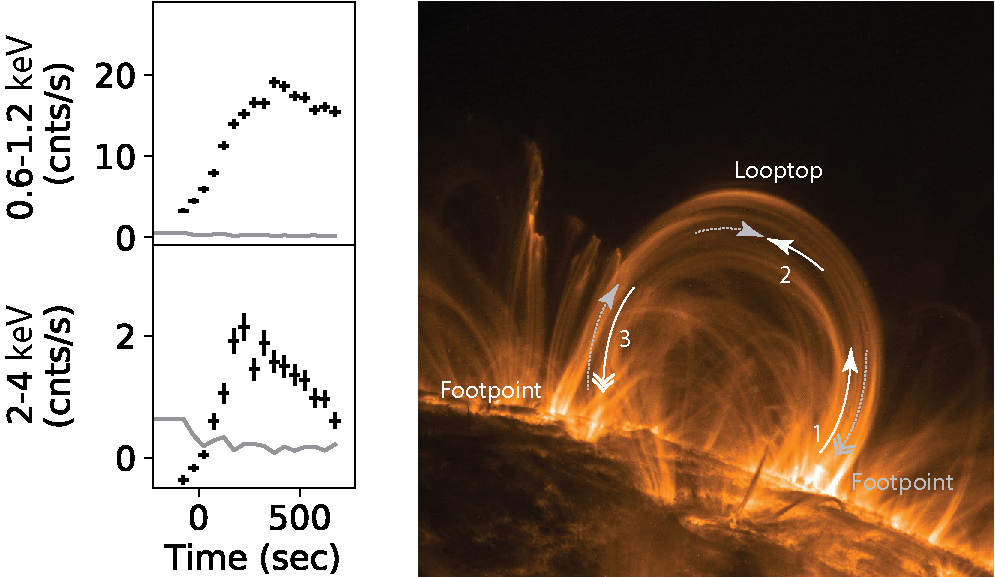NICER / ISS Science Nugget
for March 2, 2023
Delayed X-ray Brightening at Magnetic Loop Footpoints in Two Superflares from a Young Sun-like Star
Our Sun releases, unpredictably and suddenly, vast amounts of magnetic energy via its sunspots, generating flashes in X-rays and at other wavelengths. These flare events occasionally eject high-energy particles, with some ejecta reaching the Earth and occasionally disrupting the electromagnetic environment. This activity was more vigorous in ancient times, possibly affecting the formation or evolution of life. Studying such flares provides insight into our origins and the habitability of planets around other stars, while also helping to secure our assets and activities.
One way to understand the flare explosion mechanism is to observe Sun-like stars with vigorous magnetic activity. In 2019, NICER monitored the star kappa1 Ceti, a relatively nearby (30 light-years distant) young analogue to our Sun, and detected two X-ray flares more energetic than any recorded Solar flare - so-called superflares. NICER observed each flare from onset, and revealed for the first time detailed spectral variations during the flare rise. In both flare events, the time-resolved spectra require primary hot emission from plasma at 30 million Kelvin (MK) temperatures, as well as secondary cooler emission from ~10 MK plasma. These two components were found to evolve similarly, but the cool component lagged 150-200 sec behind the hot component. Earlier studies indicate that the hot component originates from a plasma that fills a flare's magnetic loops, but the nature of the cool component and its evolution were unknown, even though many stellar flare spectra require the presence of lower-temperature plasmas.
Comparison of the NICER kappa1 Ceti flare results with hydrodynamic simulations revealed that the cool component originates from plasma at the magnetic loop footpoints, which are regulated by heat conduction from the loop-filling hot plasma to the 6000 K stellar atmosphere "surface." The cool-plasma emission does not rise until the shock produced by the hot plasma at the loop top propagates down to the footpoints. This delayed X-ray brightening should occur in any stellar or Solar flare, and the time delay measurement provides an estimate of the geometric size of the magnetic loop.
This peer-reviewed study was recently published by Hamaguchi et al. (2023) in The Astrophysical Journal.

Left panels: NICER's X-ray brightness measurements of the "superflare" from the star kappa1 Ceti on September 17, 2019. The 2-4 keV (3.1-6.2 Angstrom wavelength) intensity (bottom), which traces the hot plasma component, peaks at approximately 250 sec, while the 0.6-1.2 keV (10.3-20.7 Angstrom) intensity (top), with significant contribution from a cooler component, does not peak until 400 sec. Detailed spectral analysis shows that the cool component's onset is also delayed by about 150 sec. Right panel: Schematic view of the plasma heating process. 1: Particles energized by magnetic reconnection rain down on the stellar atmosphere, evaporating gas in the vicinity of the flare loop. The hot (~30 MK) plasma emission begins to rise. 2: The evaporated gases from the either end collide near the top of the loop, producing shocks. 3: The shocks propagate down to the footpoints, increasing their plasma density. Thermal conduction becomes more efficient, and the cool (~10 MK) plasma emission rises. The background is a solar (non-flare) coronal loop image obtained with the TRACE satellite on November 6, 1999, in the 171-Angstrom passband, which traces 1 MK plasmas. We presume the kappa1 Ceti flares had similar magnetic loop geometries.
<< Previous
Main Index
Next >>